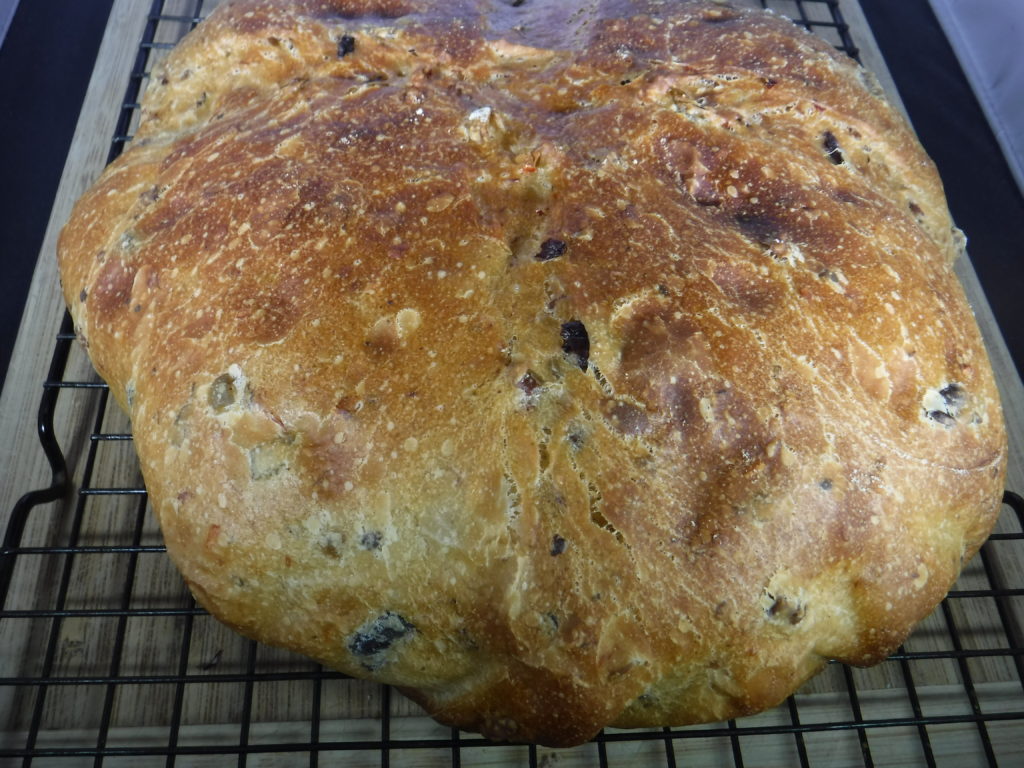
This bread has quite a complex flavor from the olives, garlic, red pepper, and bit of sugar. This version is an adaptation of a recipe in Bread Illustrated from America’s Test Kitchen. I made this based on weight of flour vs. the volume. The original recipe equated 3 cups of bread flour with 16.5 oz., which is more dense than I usually assume for flour. The dough seemed rather stiff at first, but there is moisture in the olives, so after I worked the olives into the dough it was much less stiff. In any event, the bread turned out well. At 2 tsp. of yeast, this recipe has more yeast than I usually use, so the bread was ready within a day. (About 4 hours start to finish, although it then needs cooling time.) Probably the next time, I will cut the yeast back and will have the first rise overnight in the refrigerator.
Since I have an active 50/50 sourdough culture, I usually swap out some of the flour and water in bread recipes for an equal amount of sourdough. In this case I added 4 oz. of sourdough and reduced the flour and water by 2 oz. each. The recipe below assumes no sourdough
¾ cup pitted olives, chopped
2 garlic cloves, finely chopped
16.5 oz. bread flour
2 tsp. yeast
2 tsp. salt
2 tsp. red pepper flakes
1-1/3 cups (10.67 oz.) water at room temperature
2 Tbs. sugar
1 Tbs. extra virgin olive oil
Mix together in a small bowl the olives and garlic.
In the bowl of a standing mixer, put the flour, yeast, salt, and red pepper flakes. Whisk together in a separate bowl the water, sugar, and olive oil, until all the sugar is dissolved. Using a dough hook on slow speed, slowly mix the water in with the flour mixture. When a rough dough is formed and there are no bits of dry flour, turn up the speed to medium-low, and knead the bread until if forms a smooth dough, about 8 minutes. Reducing the speed back to low, slowly add the olive/garlic mixture in ¼ cup increments until it is fully incorporated into the dough.
Put the dough on a lightly floured surface. Knead briefly and form it into a ball. Place in a covered doubling container until it has doubled, about 1.5-2 hours.
Once doubled, remove from the container and place again on a lightly floured surface. Pat the dough into a large disk. Fold the sides of the disk into the center. Form the dough into a ball, with the folded side down. Place the dough a sheet of baking parchment in a Dutch oven. Allow to expand by about 50 percent, about 30-60 minutes.
Preheat the oven to 450 degrees for at least 30 minutes. With a sharp knife, slice a cross into the top of the bread. Bake in the oven covered for about 30 minutes. Remove the cover and reduce the temperature to 375 degrees. Continue baking until the loaf is golden and sounds hollow when tapped, about another 20-25 minutes.
Remove from the oven. Carefully remove the bread from the Dutch oven using the baking parchment sheet as a handle, and cool fully on a wire rack before slicing and eating. The bread is very good with a soft cheese.


